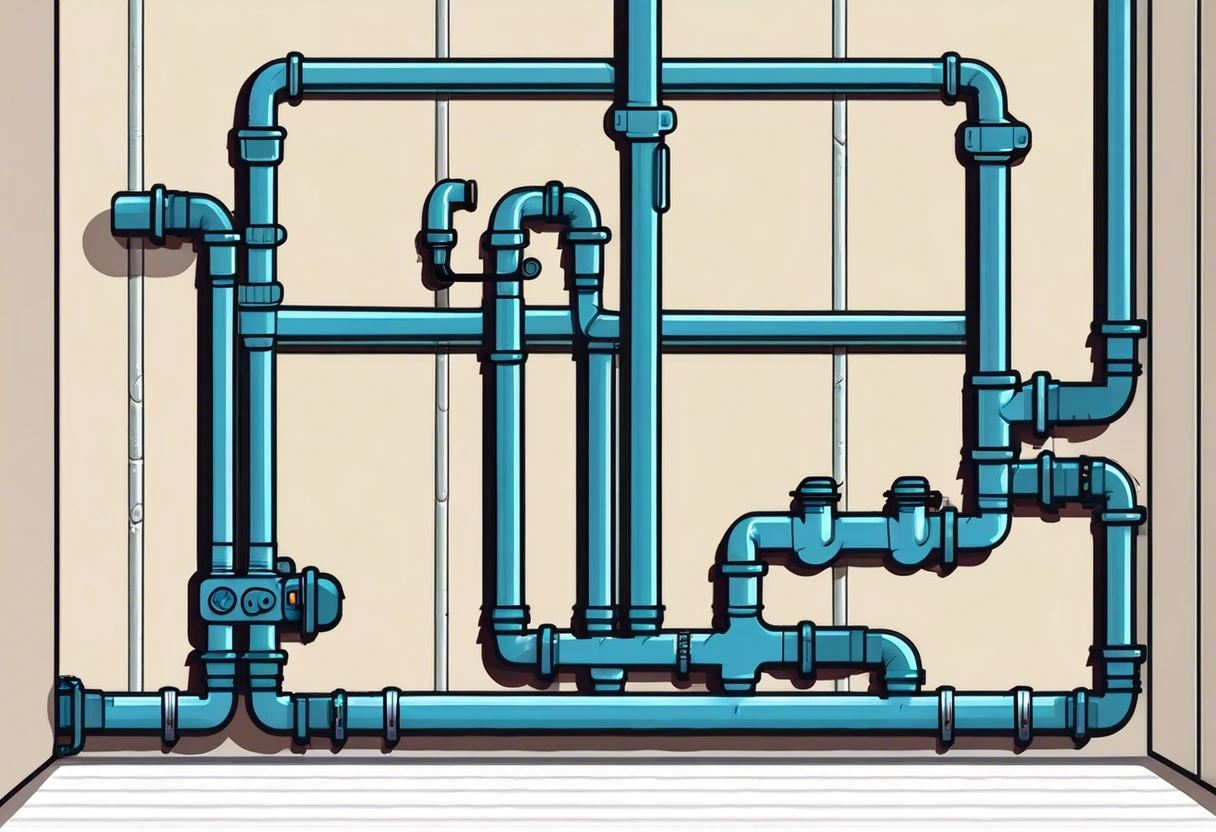How Thick is a Plumbing Wall? Discover What You Need to Know About Plumbing Wall Thickness
Published on: March 22, 2025 | Last Updated: March 22, 2025
Written By: anaheimplumbers
Hey there! If you’re curious about how thick a plumbing wall really is, you’ve come to the right spot. Whether you’re tackling a DIY project or simply pondering how plumbing systems operate, I completely understand your concerns. The thickness of plumbing walls can vary significantly, and knowing this can help you make informed decisions for your home.
I recognize that plumbing can sometimes be confusing, but don’t worry—I’m here to help you understand the appropriate thickness for plumbing walls. With my extensive experience as a plumbing expert in the Anaheim Hills area, I’ve encountered all sorts of installations and repairs. You can trust that I have the knowledge to answer your queries on this topic.
In this guide, I’ll walk you through various details, including the standard thickness measurements for plumbing walls, what factors influence those sizes, potential installation costs, and when you might want to consult a professional for assistance. So, get ready to dive deeper into the world of plumbing walls and their thickness!
Page Contents
- 1 How Thick is a Plumbing Wall?
- 2 Key Insights on Plumbing Wall Thickness
- 3 Understanding Plumbing Wall Thickness and Related Details
- 4 Understanding Plumbing Wall Insulation and Its Impact on Thickness
- 5 Special Considerations for Outdoor Plumbing Walls
- 6 Exploring Specific Plumbing Wall Thickness Measurements
- 7 When to Seek Expert Advice on Plumbing Wall Thickness
- 8 Frequently Asked Questions (FAQ)
- 9 Final Thoughts on Plumbing Wall Thickness Considerations
- 10 Useful References for You:
How Thick is a Plumbing Wall?
The answer isn’t straightforward—it typically ranges from 4 to 6 inches thick, depending on the pipes and materials used. It’s essential to consider factors like insulation, access panels, local building codes, and your specific needs for the Anaheim Hills area!
Key Insights on Plumbing Wall Thickness
Having examined the specifics of plumbing wall thickness, here are some crucial takeaways to keep in mind:
- The standard thickness of a plumbing wall typically ranges from ½ inch to ¾ inch.
- Choosing the right thickness can significantly impact flow rates and overall plumbing efficiency.
- Knowing the thickness of a plumbing wall can save you time and money during renovations.
- Consulting with a plumbing expert ensures appropriate installation and compliance with local codes.
Understanding Plumbing Wall Thickness and Related Details
One crucial lesson I’ve learned from my years of experience in the plumbing field around Anaheim Hills is that the thickness of a plumbing wall is essential not only for structural integrity but also for operational efficiency. A well-sized plumbing wall can significantly impact the success of a project, distinguishing between a reliable setup and one prone to leaks or malfunctions. The primary objective is to ensure that the pipes facilitate smooth flow, free from backlogs or ruptures. If you are considering launching your own plumbing venture, it’s vital to grasp the initial expenses involved, as this knowledge will empower you to make informed decisions. For more insights on Anaheim Hills plumbing tips and advice, you can explore detailed resources to guide your journey.
Factors Influencing Plumbing Wall Thickness
So, how thick is a plumbing wall? Generally speaking, residential plumbing walls are often approximately 4 to 5 inches (102 to 127 mm) thick, which includes the framing and any additional space necessary for plumbing. However, specific measurements can be adjusted based on various factors.
Typical Standards for Plumbing Wall Thickness
In my plumbing journey, I’ve encountered situations that often compel you to double-check the standards. For instance, plumbing walls in a bathroom or shower usually measure about 2 to 3 inches thick (51 to 76 mm). During a recent renovation in a friend’s home in Anaheim Hills, I came across a wall that was just 3 inches thick yet extended an entire yard long—while somewhat excessive, it certainly got the job done!
When we ask “how thick is a plumbing wall,” we need to factor in materials. A standard wood-frame wall often allows for smooth piping configurations. In contrast, steel walls might be thicker due to their durability, capable of enduring significant lateral forces from water pressures encountered in shower or toilet setups.
A critical lesson I learned involved retrofitting a plumbing wall for a shower. The existing wall was only 2 inches thick (51 mm), but I realized that a bathroom shower needs approximately 3 inches thick (76 mm) for proper venting and drainage. This understanding prevented me from repeating plumbing work that could lead to leaks.
It’s also vital to remember that wall thickness can be influenced by building codes in our OC territory. Make sure you are compliant! For example, a thicker wall may enhance insulation but complicate plumbing runs; achieving a balance between these priorities is crucial. I always keep local codebooks handy—better safe than sorry!
So, if you’re ever curious about plumbing wall thickness, just keep these practical applications in mind. Understanding proper thickness not only saves you headaches down the road but also ensures safety and functionality for every homeowner across Anaheim Hills. That’s an indispensable question for any DIY enthusiast!
Now that we’ve addressed plumbing wall thickness, let’s explore plumbing wall insulation and its effects on thickness.
Also See: Can a Plumbing Vent Have a 90-degree Angle?

Understanding Plumbing Wall Insulation and Its Impact on Thickness
Insulation is a critical factor in determining a plumbing wall’s thickness, particularly in the sunny region of Anaheim Hills.
Why Insulation Matters
Throughout my plumbing experience, I have come to understand the significant role insulation plays in maintaining temperature control and influencing wall structure thickness. Proper insulation is crucial for preserving the integrity of your plumbing system, especially during California’s sweltering summers and cooler winters, as it safeguards pipes from the risks of freezing and overheating. If you are considering a career in this field, you can learn more about the process by exploring how to get a plumbing license in Anaheim Hills.
Typical Insulation Thickness
The standard thickness of insulation in plumbing walls usually adds approximately 1 to 3 inches (25 to 76 mm), depending on the material used. This is a vital aspect not to overlook. Without insulation, you risk exposing your plumbing to extreme temperatures that can severely affect performance.
Types of Insulation Found in Plumbing Walls
- Fiberglass Insulation: Typically ranges from 3 to 6 inches thick, providing excellent noise reduction and thermal efficiency.
- Foam Board Insulation: Usually about 2 inches thick, offering high R-values in confined spaces.
- Spray Foam Insulation: Generally measures around 1 to 3 inches thick; it expands to fill spaces and achieve a secure fit.
Impact on Remodeling and New Installations
During a recent bathroom remodel for a client in Anaheim Hills, we prioritized insulation thickness to avoid the risk of frozen pipes. This careful selection is essential for maximizing comfort and efficiency in any plumbing project. Properly insulated plumbing walls not only enhance performance but also lead to reduced energy waste, significantly lowering utility bills in the long run. Additionally, it’s vital to grasp the nuances of bidding for plumbing jobs in this area, as this understanding can greatly influence your overall project costs. For detailed insights into effective pricing strategies, make sure to check out how to bid a plumbing job.
Now that we have a solid understanding of plumbing wall insulation and its influence on thickness, let’s move on to discussing outdoor plumbing wall considerations.
Special Considerations for Outdoor Plumbing Walls
Outdoor plumbing walls come with unique thickness requirements due to environmental conditions, especially during fire season.
Thickness Requirements for Outdoor Plumbing Walls
For outdoor plumbing installations, wall thickness generally ranges from 6 to 8 inches (152 to 203 mm) to endure the elements. I recommend verifying local codes before projects due to fire safety regulations here in OC.
Fire-Resistant Materials
In regions like Anaheim Hills, utilizing fire-resistant materials can influence wall thickness. Materials such as cement board may add about 1 inch (25 mm) in thickness, yet they provide enhanced protection during fire season.
Common Outdoor Plumbing Wall Configurations
- Outdoor Shower Walls: Typically range from 2 to 3 inches (51 to 76 mm) thick, depending on setup and plumbing needs.
- Garden Hose Bibs: Generally measure around 4 inches (102 mm) thick for adequate insulation against temperature changes.
When considering how thick a plumbing wall should be, it’s crucial to take into account factors like insulation and outdoor installations. These aspects play a vital role in preventing costly damages during winter and fire seasons. Furthermore, if you’re evaluating a home that features older plumbing systems, being aware of potential issues—such as those linked to galvanized pipes—can save you future headaches. To assist you in making a well-informed decision, you may find it beneficial to read about buying a house with galvanized plumbing.
Next, let’s examine specific plumbing wall thickness measurements.
Exploring Specific Plumbing Wall Thickness Measurements
In this section, I’ll break down the thickness of plumbing walls, which is vital for any remodeling or plumbing project.
How Thick is a Plumbing Wall in Inches?
A plumbing wall typically measures between 1½ to 2 inches (3.81 to 5.08 cm). I remember a project in Anaheim Hills where we needed to adjust the thickness to achieve a contemporary aesthetic while maintaining the functionality of the pipes. Proper management of plumbing within a wall is essential for both visual appeal and practical use. If you’re eager to enhance your skills in this area, you can explore how to plumb a wall for practical techniques that can be applied to similar projects. Additionally, it’s important to consider the role of framing studs in this process.
Plumbing Wall Thickness Measured in Millimeters (Mm)
When discussing plumbing walls in mm, typical measurements range from 38 mm to 51 mm. This variation reflects how residential standards accommodate pipes to reduce potential issues.
Plumbing Wall Thickness in Residential Spaces
In many apartments and residential areas, plumbing wall thickness may vary slightly. Generally, the standard thickness is around 2 inches, though I’ve noted variations in older structures within OC.
How Thick Should a Plumbing Wall Be for a Shower?
For a shower installation, a thickness of 2 to 3 inches (5.08 to 7.62 cm) is advised to ensure proper drainage and prevent leaks. I once dealt with significant leakage because the wall was too thin for a custom shower setup, and it was a hard lesson learned!
Bathroom Wall Thickness Specifications in Mm
In bathroom designs, wall thickness should ideally measure 50 mm to 76 mm, ensuring adequate placement of fixtures like sinks and bathtubs.
Recommended Wall Thickness for Shower Plumbing
As indicated earlier, for plumbing in showers, it’s prudent to opt for a thickness of 50 mm to about 76 mm to facilitate smooth pipe installation and avoid leaks.
Toilet Wall Thickness Guidelines in Mm
For toilet installations, normal wall thickness is typically around 38 mm to 51 mm (1½ to 2 inches). I can’t stress enough how often I receive calls regarding backup issues stemming from improper wall thickness around toilets! Plumbers should always confirm those specifications prior to installation.
Understanding Plumbing Wall Detail
Getting plumbing wall specifications right is essential for preventing future issues such as leaks or insufficient support. In high-end homes in Anaheim Hills, I’ve noticed that a refined fit and finish often make a significant difference in plumbing performance. However, everyday items like toilet paper can sometimes lead to unexpected plumbing complications. For instance, Charmin has sparked debates regarding its potential to clog pipes. To safeguard your plumbing, you might want to look into how Charmin affects plumbing and ensure everything remains in optimal working condition.
- Typical plumbing wall thickness: 1½ to 2 inches (38 to 51 mm)
- Common metrics: 38 mm to 51 mm for residential walls
- Shower setups: 2 to 3 inches (51 to 76 mm)
- Bathroom measurements: 50 mm to 76 mm for fixture stability
- Toilet-specific wall thickness: 38 mm to 51 mm
Now that we’ve covered specific plumbing wall thickness measurements, let’s address when to seek expert advice.

When to Seek Expert Advice on Plumbing Wall Thickness
Through my experiences fixing everything from clogged drains to burst pipes, I’ve come to understand the importance of knowing when to call in a professional. Recognizing the signs of serious plumbing issues can save you substantial time and money in the long run. For instance, if you notice any cracks, leaks, or weak spots in your walls, it’s a compelling indication that it’s time to reach out to a plumbing expert. Additionally, if you’re interested in learning more about how you can get plumbing fixes even if you aren’t the property owner, you can explore options to ensure that necessary repairs are handled promptly and efficiently.
It’s wise to seek someone local who thoroughly understands the complexities of plumbing in Anaheim Hills. Look for professionals with reputable backgrounds and experience in addressing local challenges, particularly when it comes to unique plumbing wall requirements. My collaboration with the good folks at Anaheim Hills Plumbers stands as proof—together, we tackled intricate wall structure issues in a home.
Hiring a local pro offers numerous advantages, as they possess a deep understanding of the area’s climate, topography, and building codes, all of which significantly impact your plumbing system. Additionally, local professionals are typically just a short drive away, making it easier to address any problems that may arise. One crucial component often found in local plumbing systems is the house trap, designed to prevent sewer gases from entering homes. To gain a deeper understanding of this essential plumbing feature, be sure to visit this page on what a house trap is.
In Anaheim Hills, it’s essential to adhere to stringent compliance regulations, particularly regarding local plumbing codes. This includes understanding critical details, such as how thick a plumbing wall should be. Before starting any excavation projects, obtaining the necessary approvals is vital. Therefore, I recommend familiarizing yourself with how to get a plumbing permit to ensure your project complies with local requirements.
Frequently Asked Questions (FAQ)
Questions about plumbing often arise, especially regarding wall specifications. Here are some unique FAQs to help you better understand this topic.
Should Plumbing Walls Be 2×6?
Yes, in most cases, plumbing walls should be 2×6. This thickness allows for adequate insulation, ventilation, and space for necessary plumbing fixtures.
How Thick is the Wall for a Toilet?
The standard wall thickness for a toilet installation typically ranges from 4 to 6 inches. This dimension is crucial as it provides adequate support and facilitates accessibility for plumbing connections. Additionally, it’s important to understand the drying time of plumbing glue during your project, as this ensures a secure and reliable fit. For detailed information on the drying time of plumbing adhesives and its significance for your installation, you can visit how long plumbing glue takes to dry.
Can You Fit Plumbing in a 2×4 Wall?
Yes, you can accommodate plumbing within a 2×4 wall, though it may feel quite cramped. This scenario demands careful planning to ensure sufficient space for pipes and fittings. To tackle these challenges effectively, integrating a power beyond valve can be particularly advantageous. If you’re interested in enhancing efficiency in your plumbing layout, consider exploring how to plumb a power beyond valve for detailed guidance.
What is the Best Wall Thickness for Running Plumbing?
The optimal wall thickness for running plumbing is usually between 4 to 6 inches. A thicker wall creates ample space for pipes and proper installation.
How Do Plumbing Walls Differ From Standard Walls?
Plumbing walls are uniquely constructed to accommodate pipes, often requiring additional framing to support the system effectively. This is in contrast to standard walls, which typically do not have such needs. To gain a deeper understanding of how plumbing systems and their components function within an apartment building, you can explore the intricacies of these setups in an apartment building.
Can Plumbing Be Installed in Non-load-bearing Walls?
Yes, plumbing can be installed in non-load-bearing walls. It’s imperative to verify that adequate thickness and support are in place for effective operation.
Final Thoughts on Plumbing Wall Thickness Considerations
In summary, we’ve covered how thick a plumbing wall should be, explored plumbing wall thickness, detailed specific thickness measurements, discussed installation costs, and outlined when to consult an expert.
To reiterate, plumbing wall thickness can vary but typically ranges from 2 to 6 inches. For more assistance, feel free to check out our services at Anaheim Hills Plumbers. You can utilize our chat function for a quick quote estimate and directly connect with professional plumbers in your area.

